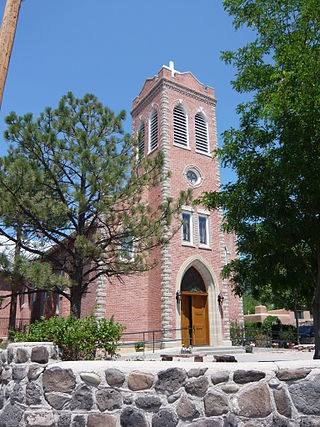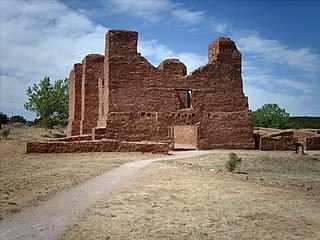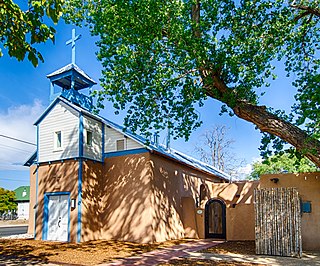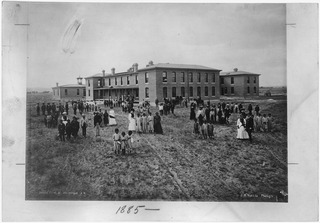
Scouting in New Mexico has had a rich and colorful history, from the 1910s to the present day, serving thousands of youth in programs that suit the environment in which they live. The state is home to the Philmont Scout Ranch.

The Old Spanish Trail is a historical trade route that connected the northern New Mexico settlements of Santa Fe, New Mexico with those of Los Angeles, California and southern California. Approximately 700 mi (1,100 km) long, the trail ran through areas of high mountains, arid deserts, and deep canyons. It is considered one of the most arduous of all trade routes ever established in the United States. Explored, in part, by Spanish explorers as early as the late 16th century, the trail was extensively used by traders with pack trains from about 1830 until the mid-1850s.

Old Town is the historic original town site of Albuquerque, New Mexico, for the provincial kingdom of Santa Fe de Nuevo México, established in 1706 by New Mexico governor Francisco Cuervo y Valdés. It is listed on the New Mexico State Register of Cultural Properties as the Old Albuquerque Historic District, and is protected by a special historic zoning designation by the city. The present-day district contains about ten blocks of historic adobe buildings surrounding Old Town Plaza. On the plaza's north side stands San Felipe de Neri Church, a Spanish colonial church constructed in 1793.

Ohkay Owingeh, known by its Spanish name as San Juan de los Caballeros from 1589 to 2005, is a pueblo and census-designated place (CDP) in Rio Arriba County, New Mexico. Ohkay Owingeh is also a federally recognized tribe of Pueblo people inhabiting the town.

Quarai, also known historically as Quarai State Monument, is a prehistoric and historic unit of the Salinas Pueblo Missions National Monument located north of Mountainair, New Mexico. A National Historic Landmark District, it encompasses the archaeological remains of prehistoric Native American settlements, historic remains of a pueblo that was abandoned in the 1670s during the Spanish colonial period, the ruins of a 17th-century Spanish mission compound, and 19th-century Spanish ranching artifacts. The site was designated a National Historic Landmark in 1962, and was added to the Salinas Pueblo Missions National Monument in 1980.

The following outline is provided as an overview of and topical guide to the U.S. state of New Mexico:

The La Luz Historic District is a 18 acres (7.3 ha) historic district in La Luz, Otero County, New Mexico, which was listed on the National Register of Historic Places in 1980. The district included 27 contributing buildings.
The Juan Garcia House, on Tularosa St. in La Luz, New Mexico, was built around 1870. It was listed on the National Register of Historic Places in 1980.

The Los Candelarias Chapel, also known as the San Antonio Chapel, is a historic building in Albuquerque, New Mexico. The chapel was built in 1888 to serve the community of Los Candelarias, one of several outlying plazas spread along the Rio Grande in the vicinity of the main plaza at Old Town Albuquerque. It is one of the only surviving buildings from the no-longer-extant plaza. The building remained in use as a chapel until the 1950s and was subsequently converted into an artist's studio and then a private residence. It was listed on the New Mexico State Register of Cultural Properties in 1983 and the National Register of Historic Places in 1984.

San Jose de los Duranes Chapel is a historic building in Albuquerque, New Mexico. The chapel was built around 1890 to serve the community of Los Duranes, one of several outlying plazas spread along the Rio Grande in the vicinity of the main plaza at Old Town Albuquerque. The chapel was replaced with a new, larger San Jose Church in the 1960s, and fell into disrepair. In 1982–4, community members undertook a restoration of the building, replacing damaged or missing pews, rails, and doors, plastering the walls, repairing holes, and reinstalling the original religious artwork including paintings of the Crucifixion and a santo depicting St. Joseph. It was listed on the New Mexico State Register of Cultural Properties in 1983 and the National Register of Historic Places in 1984.

The Barela–Bledsoe House is a historic house in the North Valley of Albuquerque, New Mexico. It was built around 1870 by Juan Estevan Barela (1842–1886), a prosperous farmer and merchant. At the time of his death, he owned over 100 acres (0.40 km2) of land and 13,000 sheep. The house was inherited by his widow Abundia García de Barela, who owned the property until her death. In the twentieth century, it was the residence of Robert Dietz III, whose previous home is also a listed historic property. The Barela–Bledsoe House was listed on the New Mexico State Register of Cultural Properties in 1976 and the National Register of Historic Places in 1979.
The Camino Real in New Mexico was the northern part of a historic roadway known as the Camino Real de Tierra Adentro that from 1598 ran from Mexico City northward through central and northern Mexico and the Trans-Pecos part of what is now Texas to San Juan Pueblo in Santa Fe de Nuevo Mexico, now the state of New Mexico.

The Juan Chavez House is a historic two-story terrone house in Albuquerque, New Mexico. It was built in 1914-1917 by Juan Chavez, a native of San Acacia, New Mexico who lived here with his wife Candelaria and their nine children. Half of the first floor was a grocery, out of which the family sold produce. Chavez also worked for a liquor wholesaler, Stern, Schloss and Company. During prohibition, which lasted from 1920 to 1933, he stored bootlegged alcohol in the upstairs bedroom. In 1948, the house was purchased by Louis Gross and his wife, Leona. He sold fruit, vegetables, and his own wine, made in Bernalillo, New Mexico. The house was later inherited by his son, Louis W. Gross. Wilhelmina (Billie) Gross, wife of Louis W. Gross, was instrumental in getting the house listed on the New Mexico State Register of Cultural Properties in 1983 and the National Register of Historic Places in 1984. The house was remodelled as a hair salon by Frank Vallejos in 1989.

The Antonio Vigil House is a historic building in the Old Town neighborhood of Albuquerque, New Mexico. It was built in 1879 as a rental property by Santiago Baca, a wealthy landowner who moved with his family to Albuquerque from Pecos, New Mexico in 1874. The home's original occupant was Albert Grunsfeld, a German Jewish merchant for whom Albuquerque's oldest Jewish congregation, Congregation Albert, is named. The Baca family sold the house in 1900, and after two changes of ownership, it ended up in the hands of Pilar Vigil in 1904. Her son Antonio Vigil lived there from 1922 to 1961 and the Vigil family continued to own the property at least into the 1970s. At some point the building was converted to commercial use. It was added to the New Mexico State Register of Cultural Properties in 1976 and the National Register of Historic Places in 1978.

The Juan de Dios Chavez House is a historic house in Albuquerque, New Mexico. The date of construction is unknown but it was probably built sometime before 1875. The property was part of the land on which Juan Cristobal Armijo built his "New Homestead" around that time, and the Juan de Dios Chavez House is thought to be older based on its architecture. Juan de Dios Chavez, who belonged to an old North Valley family, acquired the house in the early 20th century. The house was added to the New Mexico State Register of Cultural Properties in 1983 and the National Register of Historic Places in 1984.

The Charles Grande House is a historic farmhouse in Albuquerque, New Mexico. It was built in 1915 by Charles Grande, an Italian immigrant who worked in the hotel and saloon business, and his wife Carmelita Garcia, who was from a New Mexico family. The Grandes operated a vineyard and raised livestock on the property, which was later subdivided for residential development in the 1950s. The building was added to the New Mexico State Register of Cultural Properties in 1983 and the National Register of Historic Places in 1984.

Albuquerque Indian School (AIS) was a Native American boarding school in Albuquerque, New Mexico, which operated from 1881 to 1981. It was one of the oldest and largest off-reservation boarding schools in the United States. For most of its history it was run by the Bureau of Indian Affairs (BIA). Like other government boarding schools, AIS was modeled after the Carlisle Indian Industrial School, using strict military-style discipline to strip students of their native identity and assimilate them into white American culture. The curriculum focused on literacy and vocational skills, with field work components on farms or railroads for boys and as domestic help for girls. In the 1930s, as the philosophy around Indian education changed, the school shifted away from the military approach and offered more training in traditional crafts like pottery, weaving, and silversmithing.
The Tomasa Griego de Garcia House is a historic house in the North Valley of Albuquerque, New Mexico. Its exact age is not known, but it was probably built in the mid-1850s and belonged to Tomasa Griego de Garcia until her death in 1890. The property remained in her family's possession until 1947. In the 1950s, it was purchased by the Koeber family, who enclosed the entrance, rebuilt a collapsed part of the west wing, and added plumbing and electricity. It is located on a private drive just south of another historic building, the Barela–Bledsoe House.

The Robert Dietz Farmhouse is a historic house in the North Valley of Albuquerque, New Mexico. It was originally a one-story farmhouse built in 1914 by Robert Dietz, a native of Syracuse, New York, who moved to Albuquerque in 1910 like many others seeking treatment for tuberculosis. A second story was added in 1928, turning the building into a "grand home". The Dietz family lived and farmed there until the 1940s. It was listed on the New Mexico State Register of Cultural Properties in 1983 and the National Register of Historic Places in 1984.
The C. M. Foraker Farmhouse was a historic house in the Near North Valley neighborhood of Albuquerque, New Mexico. It was built near the turn of the 20th century and was purchased around 1900 by C. M. Foraker, the last U.S. Marshal for New Mexico Territory before New Mexico gained statehood in 1912. Foraker's daughter Mary still owned the house at the time of its National Register of Historic Places listing in 1984. It was also listed on the New Mexico State Register of Cultural Properties in 1983.


















